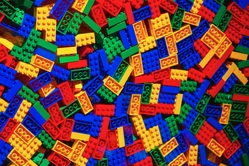By 1951, more than half of the outputs from Christiansen’s toy company were plastic. This despite his native country’s trade magazine, Toy-Times, believing that plastic would never be able to replace traditional wooden toys.
The plastic toys that Christiansen’s toy company became known for were interlocking bricks, which we all know of as the familiar Lego bricks.
interlocking bricks, which we all know of as the familiar Lego bricks.
Those simple interlocking plastic bricks have developed into a subculture, six theme parks, video and board games, movies, and clothing. By July 2015, it is estimated that 600 billion Lego parts have been produced, and Lego was named one of the world’s most powerful brands.
But how does a simple idea like making a plastic toy brick develop into such a powerful and successful brand?
It is unlikely that Christiansen started developing his plastic bricks with the knowledge that it would develop into what it did. Rather, he had a motto for the Lego Group that translates roughly to “the best is never too good.” From that, he took pride in what he was developing and opened himself up to pivot with his company while also remaining true to the very simple interlocking brick. (A Lego brick today can interlock with some of those first Lego bricks made back in the ‘40s.)
As the bricks were pieced together by amateurs and professionals alike, the company continued to pivot – creating new bricks, new colors, and entering into new fields like education and robotics. And then making licensing deals for brands such as Star Wars, Harry Potter, DC and Marvel Superheroes, that toy makers around the world would be jealous of.
And there were missteps. Who remembers the Lego toy metal cars from the 1960s?
The organization stayed true to their simple motto of never settling for less than the best when it came to its very simple interlocking brick, and opened itself up to new opportunities as they developed. It is likely that not each opportunity was as successful as Lego may have hoped, but it seems that they learned and continued to learn, pivot, and grow to be a massive brand.
You may have a concept that seems small, and no idea yet how it can be built into something bigger. How can you stay true to the concept and pivot and learn as you move forward?
